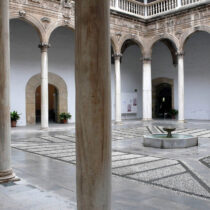The restoration works done on the Virgin Hodegetria icon, no 3018, of the Benaki Museum, Athens, offer us a good opportunity to stress the importance of restoration for the study and evaluation of works of art. The methods applied for the diagnosis and restoration of the damages of the icon brought to light a series of data which help us to understand the painter’s technique and draw conclusions as regards the dating of the work, since the work bears no signature or date of execution. The exposure of the painting to infrared and ultraviolet radiation revealed vandalisms and overpaintings, gradation of high-lights, density of varnish, etc. The careful examinaton of the painting surface with the help of a micro-stereo – scope disclosed the technical characteristics of the painter. Red lines (cinnabar) have been used for the smooth transition from the lighted to shadowed areas, while brown brush strokes, precede the pictorial description of the hair and seem to play the same role.
The radiography of the work revealed the hagiographer’s incised sketch of the Virgin and Child. The sections made on the layer of painting showed that the lacquer on the Virgin’s ma-phorion belongs to the later layer of painting, while the underpaint has an orange colour. For the angels’ garments, on the contrary, a thick layer of lacquer has been used as underpaint on which the high lights are painterd. The flesh is coloured yelllow-pink and the underpaint grey-green. Finally, the pigment analysis with X-rays produced the underpaint of the Virgin’s maphorion, the mineral ochre content of haematitic origin and the use of pure cinnabar in the red brush-strokes. The result of this entire effort was worthy since it yielded beyond doubt the artist’s technique at the time when the icon must have been painted.

